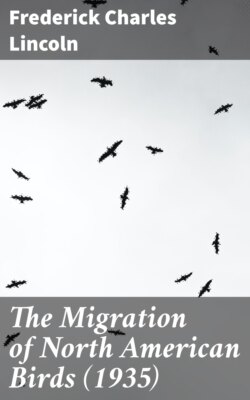Читать книгу The Migration of North American Birds (1935) - Frederick Charles Lincoln - Страница 10
На сайте Литреса книга снята с продажи.
THEORY OF PHOTOPERIODISM
ОглавлениеA modern view, based on studies of living behavior, favors the theory of photoperiodism, propounded by recent investigators as the cause of the annually induced movements of the birds. This theory holds as its major premise that quantity of light and length of day are the stimulating causes of migration. Its proponents urge that migration is a phenomenon far too regular to be created anew each season merely under stress of circumstances, such as need for food; and that it begins before the necessity for a change in latitude becomes at all pressing. Swallows, nighthawks (Chordeiles minor), shore birds, and others may start their southward movement while the summer food supply in the North is at peak abundance; while robins (Turdus migratorius), bluebirds (Sialia sialis), and others may leave an abundant food in the South in spring and press toward northern points when the food supplies there are almost entirely lacking and when severe cold and storms are likely to play havoc with the advance migrants. The regularity of arrival and departure is one of the most impressive features of migration, and since birds travel in almost strict accordance with the calendar, the proponents of the theory ask: What phenomenon to which we may attribute the stimulating impulse occurs with such precise regularity as the constantly increasing light in spring?
Experimental work has abundantly demonstrated the effect of increased light upon the growth, flowering, and fruiting of plants. Similarly, experiments with the common junco, or snowbird (Junco hyemalis), reported by Rowan (42, p. 121), resulted in increased development of the sexual organs by the end of December, although the birds were confined in outdoor aviaries in Canada and had been exposed to temperatures as low as -44° F. From the first of November until early in January, the juncos were subjected to ever-increasing light, supplied in the aviaries by electric bulbs. As regards illumination, they were thus artificially provided with conditions approximating those of spring. At the close of this period, it was found that the sexual organs of the birds had attained the maximum development normally associated with spring. With gradual reduction of the lighting over a period of little more than 1 month, the organs returned to their normal winter condition.
After a consideration of all evidence, including the fact that no ultraviolet rays were used, it was concluded that the explanation lay in the increased exercise taken during the periods of increased light. A simple test whereby certain birds were forced by mechanical means to take more exercise, the light being so reduced that there was merely sufficient glow for them to see the advancing mechanism that forced them into movement, showed that the rate of development of the sexual organs exactly paralleled that in the birds that were exposed to extended periods of illumination in the outdoor aviaries. Other features in this experiment—such as the behavior of the birds themselves—also indicated that more activity due to increased light is the governing cause of the spring development of the sexual organs. If this development be accepted as a controlling cause of migration, then this experiment must be recognized as of great importance.
Upon closer analysis, however, it is found that this theory, like those before discussed, is open to serious objections. First, some of our summer residents that migrate south for the winter do not stop in equatorial regions, where they might find the periods of day and night about equally divided, but push on beyond, some penetrating as far south as Patagonia. Also it might be asked: If the lengthening day is the stimulating factor, why should our summer birds wintering in the Tropics ever start northward, as in their winter quarters the variation in the length of day from winter to summer is imperceptible. Like all the other theories advanced, this also, as at present understood, is subject to unanswered criticism.
